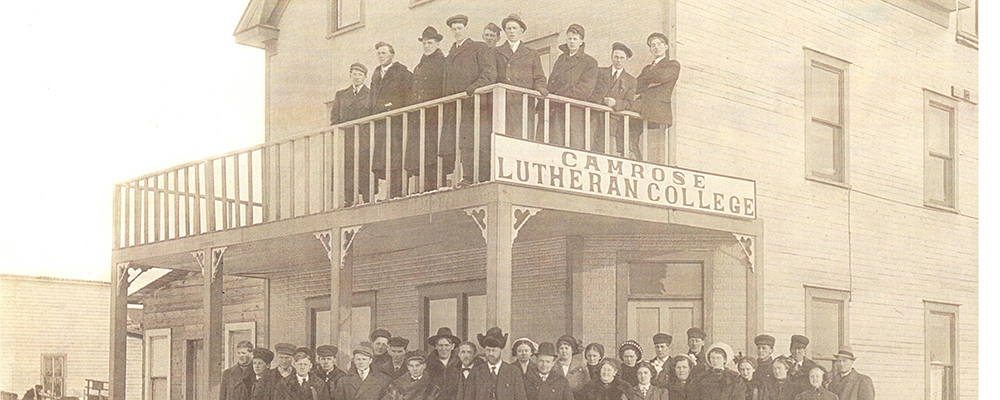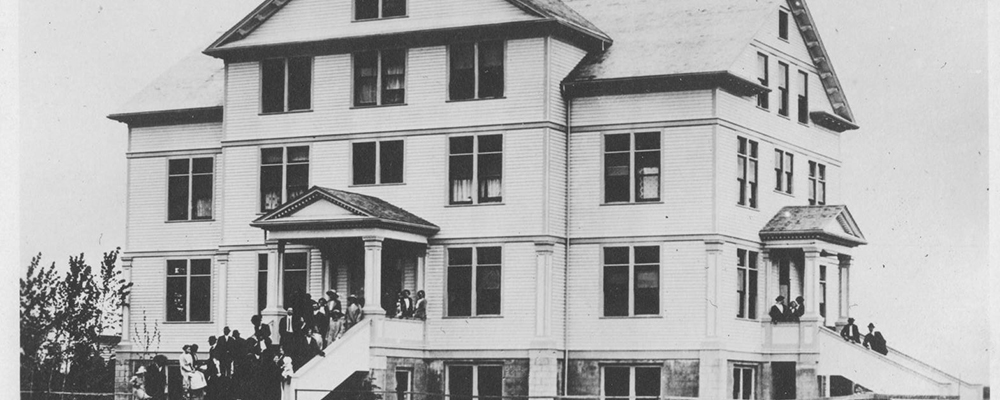Augustana celebrates 110 years
Lori Larsen, Camrose Booster - 19 May 2021

This year marks 110 years that the University of Alberta Augustana Campus (formerly Camrose Lutheran College) has been serving the educational and other needs of students in Camrose, while contributing to the growing success of the community.
As one of the oldest educational institutions in the province, Augustana has stood the test of time and has progressed through the years to be a respected and forward-thinking institution of higher learning, research and student
development.
On June 29, 1910, members of six Norwegian Lutheran congregations, along with three pastors, met in Camrose to discuss the feasibility of building a school in the area to offer residential high school education.
CLC began its first school year on Oct. 2, 1911, with Reverend J. P. Tanberg (president of the college) at the helm. Classes were held in the two Lutheran churches, and the Heather Brae Hotel was rented for $200 per month to provide the dormitory and boarding club.
With classes underway, the construction of a more permanent building began with the laying of the cornerstone on July 1, 1911. The building (then named Old Main, now Founders’ Hall) quickly began to take form and was erected in the summer and fall of 1912. On Oct. 21, 1912, Old Main was ready to welcome students for the second academic year of CLC.

CLC was not immune to the devastating impact of the Great Depression beginning in 1929, and staff sometimes only received part salaries and took food and other merchandise in lieu of tuition from students, who due to financial restraint would not have been able to attend the college.
Until the ’40s, Old Main was the only building on campus. Then an army barracks was purchased and moved on campus to be remodeled into a gymnasium and dormitory for male students. The second permanent building, constructed in 1952, was the dormitory, which was located west of the Old Main building.

In 1958, the college hit a major milestone when it was granted Junior College status and began offering first-year university transfer courses in the fall of 1959, with an affiliation with the University of Alberta. The college began offering second-year university transfer courses in 1969.
To accommodate the university classes, a new building was added to the now growing facility.
During the ’60s and ’70s, other buildings including a gymnasium and a girls’ dormitory, and five other dormitories were added to the campus.
“We were just kids, 15 to 19 years old,” smiled alumni Agnes Hoveland. “We learned to question and challenge in a time of reluctant permission to question. We grew up here, developed wings to stretch, confidence and permission to soar. And that is no different now.”

Between 1976 and 1980, Founders’ Hall was renovated and the remaining ravine residences were built. In 1981, the Science building was completed.
In 1985, Augustana became Alberta’s first privately-run degree-granting institution and a university-college. The university-college became Augustana University College in 1991, named after a Lutheran confession published in Augsberg in 1536, which became known more commonly in Scandinavians “the Augustana”.
The last high school Grade 12 graduation at Augustana was celebrated in 1992.
Between 1990 and 1992, the Faith and Life Centre opened on campus, and between 1992 and 1993, the Camrose Lutheran Church was moved to campus and renovated to become the Theatre Centre, adding to the charm and uniqueness of the campus.

On July 1, 2004, a monumental merger occurred between two of Alberta’s oldest educational institutions–Augustana University College (formerly Camrose Lutheran College) and the University of Alberta. The merger was not only a landmark decision for educational institutions, but a huge turn of events for Camrose and surrounding area.
“It is now almost 17 years since the merger,” said Chair of the Camrose Lutheran College Corporation Agnes Hoveland. “As time goes by, there is a loss of institutional memory, and when we have an opportunity to celebrate, as we do now, it is important to remember and celebrate why and how Augustana came to be, why this place was so important and unique then, and remains so now 110 years later.”
Expanding an outstanding education experience for all students has been and continues to be Augustana’s mandate. In 2007, the Learning & Beyond office (currently part of the Student Academic Services office), Aboriginal Students office (currently the Indigenous Student Services office) and Augustana Fitness Centre was opened, and in 2010, Augustana celebrated the grand opening of the library.
In 2011, Augustana celebrated 100 years as a campus during the Centenary Homecoming, and celebration. The weekend of events was enjoyed by staff, students (past and present), faculty and the community. In the same year, the North Hall was demolished, making way for progression. In 2014, Founders’ Hall was renovated and the Jeanne and Peter Lougheed Performing Arts Centre was completed, serving a vital role in the offerings to the community as a whole.
Celebrating the important role of “kinship”, Augustana opened the Wahkohtowin Lodge, and between 2015 and 2016, opened Miquelon Lake Research Station reflecting the new University of Alberta strategic plan, positioning Augustana as “a leading liberal arts college, and as a living laboratory for teaching and learning innovation, to the benefit of the entire university”.
Moving forward has always been the goal of Augustana while meeting the changing needs of students, and in 2017, the three-eleven calendar and First Year Seminar innovative undergraduate programming was introduced.
In 2020, history was made around the world when COVID-19 and the announcement of a world pandemic brought nations of people to their knees.
Shock, fear, uncertainty and worry was accompanied by hope, challenge, compassion and innovation, and despite the physical shutdown of the campus, faculty and staff pulled together, along with the resilience of the students, and continued to offer quality education through online service.
“I believe that Augustana is still inspired by and reflective of the pioneer legacy that leadership is demonstrated in service, and that through liberal education, a wholeness of being emerges,” remarked Hoveland. “The vision and mission of this place is the same now as that articulated by the founding pioneers. To Lead and to Serve were defined then, and remain core values of this place.”
Augustana continues to serve over 1,000 students annually, from across Canada and some 28 countries worldwide, and to be a vital part of the Camrose community and surrounding area.
This article was originally published in the Camrose Booster on April 27, 2021.